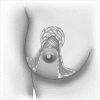Comparison of outcomes of standard and oncoplastic breast-conserving surgery
- PMID: 23843852
- PMCID: PMC3706865
- DOI: 10.4048/jbc.2013.16.2.193
Comparison of outcomes of standard and oncoplastic breast-conserving surgery
Abstract
Purpose: The aim of this study is to determine and to compare the oncological outcomes of bilateral reduction mammoplasty to standard breast-conserving surgery for breast cancer.
Methods: One hundred sixty-two patients who received a quadrantectomy because of breast cancer (group 1) and 106 breast cancer patients with macromastia who underwent breast-conserving surgery via bilateral reduction mammoplasty (group 2) between 2003 and 2010 were enrolled in this study.
Results: The mean follow-up time was 37 months for group 1 and 33 months for group 2. Surgical margins were wider than 2 mm in 82.7% and 10 mm in 76.5% of the patients in group 1. Eleven percent of patients had positive surgical margins in this group. When compared to group 2, the rates were 89%, 84%, and 8.4%, respectively. Three patients (1.8%) in group 1 and one patient (0.9%) in group 2 had local recurrence of the disease and received a mastectomy. No statistical significances were noted for either local recurrence or overall survival between the two groups.
Conclusion: Bilateral reduction mammoplasty has some advantages as compared to the standard conventional breast-conserving surgery techniques without having any unfavorable effects on surgical margin confidence, local recurrence, and survival rates.
Keywords: Breast neoplasms; Mammoplasty; Oncoplastic surgery; Segmental mastectomy.
Conflict of interest statement
The authors declare that they have no competing interests.
Figures
Similar articles
-
The Role of Oncoplastic Breast Surgery in Breast Cancer Treatment.J Breast Health. 2015 Jan 1;11(1):1-9. doi: 10.5152/tjbh.2014.2215. eCollection 2015 Jan. J Breast Health. 2015. PMID: 28331682 Free PMC article. Review.
-
Oncological advantages of oncoplastic breast-conserving surgery in treatment of early breast cancer.Breast J. 2013 Jan-Feb;19(1):56-63. doi: 10.1111/tbj.12047. Breast J. 2013. PMID: 23301761
-
A Comparative Retrospective Analysis of Complications After Oncoplastic Breast Reduction and Breast Reduction for Benign Macromastia: Are These Procedures Equally Safe?Ann Plast Surg. 2015 Oct;75(4):370-5. doi: 10.1097/SAP.0000000000000159. Ann Plast Surg. 2015. PMID: 24691307
-
Comparative study of surgical and oncological outcomes in oncoplastic versus non oncoplastic breast-conserving surgery for breast cancer treatment.JPRAS Open. 2021 Jun 6;29:184-194. doi: 10.1016/j.jpra.2021.05.010. eCollection 2021 Sep. JPRAS Open. 2021. PMID: 34258368 Free PMC article.
-
Oncological and cosmetic outcomes of oncoplastic breast conserving surgery.Eur J Surg Oncol. 2005 Oct;31(8):817-23. doi: 10.1016/j.ejso.2005.05.010. Eur J Surg Oncol. 2005. PMID: 16043322 Review.
Cited by
-
Comparison of Oncoplastic Breast-Conserving Surgery and Breast-Conserving Surgery Alone: A Meta-Analysis.J Breast Cancer. 2018 Sep;21(3):321-329. doi: 10.4048/jbc.2018.21.e36. Epub 2018 Aug 28. J Breast Cancer. 2018. PMID: 30275861 Free PMC article.
-
Oncoplastic Level II Surgical Techniques for Breast Cancer Treatment: Long-Term Outcomes.Breast Care (Basel). 2022 Feb;17(1):24-30. doi: 10.1159/000514468. Epub 2021 Mar 1. Breast Care (Basel). 2022. PMID: 35355700 Free PMC article.
-
The Role of Oncoplastic Breast Surgery in Breast Cancer Treatment.J Breast Health. 2015 Jan 1;11(1):1-9. doi: 10.5152/tjbh.2014.2215. eCollection 2015 Jan. J Breast Health. 2015. PMID: 28331682 Free PMC article. Review.
-
Surgeon Factors Influencing Breast Surgery Outcomes: A Scoping Review to Define the Modern Breast Surgical Oncologist.Ann Surg Oncol. 2023 Aug;30(8):4695-4713. doi: 10.1245/s10434-023-13472-w. Epub 2023 Apr 10. Ann Surg Oncol. 2023. PMID: 37036590
-
Oncoplastic breast-conserving surgery for women with primary breast cancer.Cochrane Database Syst Rev. 2021 Oct 29;10(10):CD013658. doi: 10.1002/14651858.CD013658.pub2. Cochrane Database Syst Rev. 2021. PMID: 34713449 Free PMC article.
References
-
- Veronesi U, Cascinelli N, Mariani L, Greco M, Saccozzi R, Luini A, et al. Twenty-year follow-up of a randomized study comparing breast-conserving surgery with radical mastectomy for early breast cancer. N Engl J Med. 2002;347:1227–1232. - PubMed
-
- van Dongen JA, Voogd AC, Fentiman IS, Legrand C, Sylvester RJ, Tong D, et al. Long-term results of a randomized trial comparing breast-conserving therapy with mastectomy: European Organization for Research and Treatment of Cancer 10801 trial. J Natl Cancer Inst. 2000;92:1143–1150. - PubMed
-
- Morrow M. Minimally invasive surgery for breast cancer. BMJ. 2009;338:b557. - PubMed
-
- Veronesi U, Marubini E, Mariani L, Galimberti V, Luini A, Veronesi P, et al. Radiotherapy after breast-conserving surgery in small breast carcinoma: long-term results of a randomized trial. Ann Oncol. 2001;12:997–1003. - PubMed
-
- Spear SL, Pelletiere CV, Wolfe AJ, Tsangaris TN, Pennanen MF. Experience with reduction mammaplasty combined with breast conservation therapy in the treatment of breast cancer. Plast Reconstr Surg. 2003;111:1102–1109. - PubMed
LinkOut - more resources
Full Text Sources
Other Literature Sources




